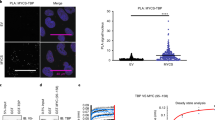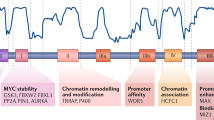Abstract
THE proteins encoded by the myc gene family are involved in the control of cell proliferation and differentiation, and aberrant expression of myc proteins has been implicated in the genesis of a variety of neoplasms1. In the carboxyl terminus, myc proteins have two domains that encode a basic domain/helix–loop–helix and a leucine zipper motif, respectively. These motifs are involved both in DNA binding and in protein dimerization2–5. In addition, myc protein family members share several regions of highly conserved amino acids in their amino termini that are essential for transformation6,7. We report here that an N-terminal domain present in both the c-myc and N-myc proteins mediates binding to the retinoblastoma gene product, pRb. We show that the human papilloma virus E7 protein competes with c-myc for binding to pRb, indicating that these proteins share overlapping binding sites on pRb. Furthermore, a mutant Rb protein from a human tumour cell line that carried a 35-amino-acid deletion in its C terminus failed to bind to c-myc. Our results suggest that c-myc and pRb cooperate through direct binding to control cell proliferation.
This is a preview of subscription content, access via your institution
Access options
Subscribe to this journal
Receive 51 print issues and online access
$199.00 per year
only $3.90 per issue
Buy this article
- Purchase on Springer Link
- Instant access to full article PDF
Prices may be subject to local taxes which are calculated during checkout
Similar content being viewed by others
References
Lüscher, B. & Eisenman, R. N. Genes Dev. 4, 2025–2035 (1990).
Murre, C. M. M., McCaw, P. S. & Baltimore, D. Cell 56, 777–783 (1989).
Blackwood, E. M. & Eisenman, R. N. Science 251, 1211–1217 (1991).
Blackwell, T. K. et al. Science 250, 1149–1151 (1990).
Pendergast, G. C. & Ziff, E. B. Science 251, 186–189 (1991).
Stone, J. et al. Molec. cell. Biol. 7, 1697–1709 (1987).
Sugiyama, A. et al. Proc. natn. Acad. Sci. U.S.A. 86, 9144–9148 (1989).
Moore, J. P., Hancock, D. C., Littlewood, T. D. & Evan, G. I. Oncogene Res. 2, 65–80 (1987).
Smith, D. B. & Johnson, K. S. Gene 67, 31–40 (1988).
Kaelin, W. G. et al. Cell 64, 521–532 (1991).
Lee, W. H. et al. Nature 329, 642–645 (1987).
Whyte, P. et al. Nature 334, 124–129 (1988).
Friend, S. H. et al. Nature 323, 643–646 (1986).
Hu, Q., Dyson, N. & Harlow, E. EMBO J. 9, 1147–1155 (1990).
Dyson, N., Howley, P. M., Münger, K. & Harlow, E. Science 243, 934–936 (1989).
Horowitz, J. M. et al. Science 243, 937–940 (1989).
Yandell, D. W. et al. New Engl. J. Med. 321, 1689–1695 (1989).
Dunn, J. M. et al. Molec. cell. Biol. 9, 4596–4604 (1989).
Land, H., Parada, L. F. & Weinberg, R. A. Nature 304, 596–602 (1983).
Ruley, H. E. Nature 304, 602–606 (1983).
Ralston, R. & Bishop, J. M. Nature 306, 803–806 (1983).
Figge, J., Wester, T., Smith, T. F. & Paucha, E. J. Virol. 62, 1814–1818 (1988).
Whyte, P., Williamson, N. M. & Harlow, E. Cell 56, 67–75 (1989).
De Caprio, J. A. et al Cell 54, 275–283 (1988).
Heikkila, R. et al. Nature 328, 445–449 (1987).
Rustgi, A. K., Van't Veer, L. J. & Bernards, R. Proc. natn. Acad. Sci. U.S.A. 87, 8707–8710 (1990).
Windle, J. J. et al. Nature 343, 665–669 (1990).
Jones, R. E. et al. J. biol. Chem. 265, 12782–12785 (1990).
Author information
Authors and Affiliations
Rights and permissions
About this article
Cite this article
Rustgi, A., Dyson, N. & Bernards, R. Amino-terminal domains of c-myc and N-myc proteins mediate binding to the retinoblastoma gene product. Nature 352, 541–544 (1991). https://doi.org/10.1038/352541a0
Received:
Accepted:
Issue Date:
DOI: https://doi.org/10.1038/352541a0
This article is cited by
-
Redeployment of Myc and E2f1–3 drives Rb-deficient cell cycles
Nature Cell Biology (2015)
-
RB-loss puts focus on Myc
Nature Cell Biology (2015)
-
Molecular basis for the actions of Hsp90 inhibitors and cancer therapy
The Journal of Antibiotics (2011)
-
A structure-based method for identifying DNA-binding proteins and their sites of DNA-interaction
Journal of Structural and Functional Genomics (2005)
-
A structure-based method for identifying DNA-binding proteins and their sites of DNA-interaction
Journal of Structural and Functional Genomics (2004)
Comments
By submitting a comment you agree to abide by our Terms and Community Guidelines. If you find something abusive or that does not comply with our terms or guidelines please flag it as inappropriate.



